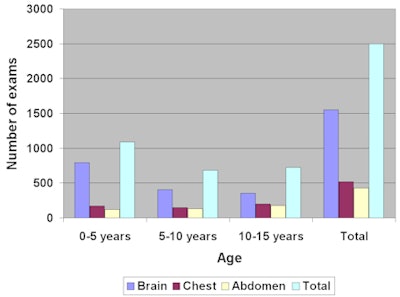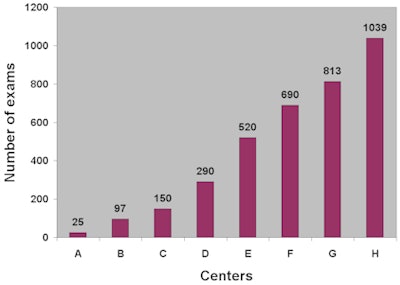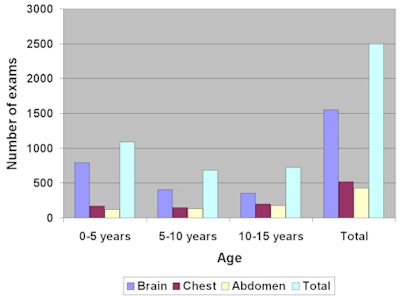
When a child needs a CT exam of the head, chest, or abdomen in Switzerland, pediatricians and parents can be assured that the radiation dose exposure will be identical regardless of the hospital in which the procedure is performed. The country's success in standardizing pediatric CT dose could provide a model for similar efforts under way in the U.S.
Hospitals in Switzerland have uniformly adopted a set of dose reference levels (DRLs) for pediatric CT that are a function of age and weight of the patient. The move was the result of a national survey conducted by University of Lausanne researchers that discovered disturbing variations in pediatric CT dose at different hospitals in the country.
The survey queried Swiss hospitals in 2005 regarding the dose delivered to pediatric patients at their institutions during CT exams of the brain, chest, and abdomen. The results were published in a recent issue of European Radiology (September 2008, Vol. 18:9, pp.1,980-1,986).
Coded questionnaires were sent to the 10 hospitals in the country that performed pediatric CT exams, eight of which responded in full. Data were requested for four age/weight groups: younger than 1 year or under 10 kg, 1-5 years or 10-20 kg, 5-10 years or 20-35 kg, and 10-15 years or over 35 kg. For each type of examination and each age group, the type of CT unit and the CT parameters (number of series, use of contrast, tube kV and current, rotation time, reconstruction slice thickness, pitch, displayed volume CT dose index, and dose length product) were requested.
The total number of pediatric CT exams performed by eight of the 10 survey participants in calendar year 2005 was 3,624. The number of procedures ranged from 25 to 1,039 per center. The researchers estimated that between 4,000 and 5,000 CT exams were performed on children younger than age 15 in 2005, according to lead author Dr. Francis Verdun, a radiation physicist at the University Institute for Radiation Physics.
| Total number of pediatric CT exams performed by eight centers in 2005 |
 |
Of the hospitals that specified the number of procedures by type of exam, 1,551 CT brain scans, 517 chest scans, and 428 abdominal scans were performed. Of the total, 41% of all CT exams were performed on newborns and children younger than 5 years of age, 27% were performed on children 5-10 years of age, and 32% were performed on those 10-15 years of age. Three centers that provided data separately for infants younger than 12 months and children 1-5 years of age indicated that 16% of their procedures in the 0-5 year age group were performed on infants.
| Number of exams per examination type |
 |
Large variations in dose among the different centers validated the second objective of the survey, which was to determine the need to initiate a set of standard DRL values for brain, chest, and abdomen CT exams based on age/weight of patients.
Variations of displayed volume CT dose index by procedure type and patient age
|
Although the study wasn't published until last month, results were made available within Switzerland in 2006, and the resulting concern drew the attention of the Swiss Society of Pediatric Radiology. Starting in 2007, the society, working in conjunction with the Swiss federal government, implemented a program to establish standardized dose values for all hospitals in Switzerland.
Radiation dose with respect to the DRL is verified at each hospital by inspectors of the Federal Office for Public Health when CT units are audited, according to Verdun. He noted that in the near future, this will also be done by the medical physicists of each hospital.
The University Institute for Radiation Physics is currently working on a project to standardize radiation dose for cardiac CT exams for both children and young adults, Verdun reports. The Institute welcomes international collaboration on this project.
In an interview with AuntMinnie.com, Verdun said that the Swiss Society of Pediatric Radiology was active both in the initiative to collect the survey data, and also in the subsequent work to implement the DRL program.
In the U.S., pediatric radiologists have been involved in the Alliance for Radiation Safety in Pediatric Imaging's Image Gently campaign, which aims to draw awareness to pediatric CT radiation dose. Getting radiologists involved is a necessary component of any dose optimization campaign, Verdun believes.
"It was very important to have [the Swiss Society] with us as a stakeholder. Patient dose optimization without a strong involvement of radiologists simply does not work," he emphasized.
By Cynthia Keen
AuntMinnie.com staff writer
October 23, 2008
Related Reading
Cincinnati meeting starts long rode to harmonize CT dose displays, September 17, 2008
Study: Radiologists dial back on pediatric CT settings, September 4, 2008
Lower tube current, modulation reduce pediatric CTA dose, May 21, 2008
Pediatric CT dose drops with breast shields plus tube modulation, February 26, 2008
Copyright © 2008 AuntMinnie.com


















